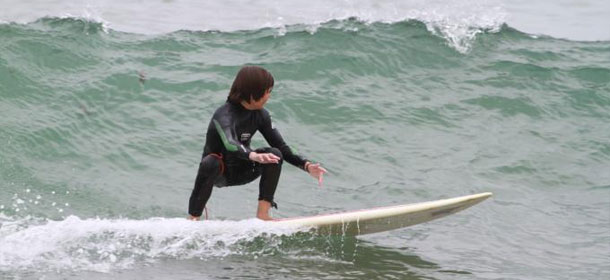Catching Unbroken Waves
5 comments
Catching unbroken (clean) waves has a completely different feel from catching a (whitewater) wave that has already broken. If you've caught whitewater, you will have felt the bumps and turbulence, and probably experienced your board sink as you have tried to pop up onto your feet. With clean waves, you'll encounter a much smoother ride. If you are lucky, you might even get a drop — the feeling of riding from the crest of the wave and scooting downwards. An unbroken wave will feel much more solid, and it might surprise you to find that it is actually easier to pop up on.
Let's be honest, you've not really surfed until you have been up and riding on a clean face. Sorry about that, it had to be said. Don't worry though, it won't be long now!
Catching unbroken waves will require bringing together several different skills, no doubt you have been utilising the guides on this site. If not, here's the essentials you'll need.
Paddling
You'll have to be proficient at paddling in order to get out past the breaking waves, manoeuver into position, and paddle to catch one.
The Pop Up
If you want to catch and then ride, (actually surf!) make sure you have practiced the pop up.
Duck diving
Learning this will help you get into the lineup without any fuss. Practice this one and increase you chances of being in position quickly.
Positioning
Getting out back and into the correct position in the line up is key to catching unbroken waves.
Get into Position
The first thing you'll need accomplish is to paddle out beyond the breaking waves and get into the lineup. This can be an exhausting process when you are new to surfing, all that paddling and duckdiving. If you feel tired, or are out of breath when you arrive "out back", relax and take it easy until you feel fully recovered. You'll need to be physically ready to catch the wave. If you are able to sit on your surfboard, do so. It'll give you a much better view of what's coming your way.
Timing your paddling correctly is something you'll learn the more practice you get. Watch other surfers to see then they start paddling. This should give you a better idea of when you should be making your move.
As a wave approaches, make sure you are facing towards the shore, as you would do to catch whitewater waves. (This time you'll be up and riding before it breaks!) Start paddling, keep looking behind you to judge how much more paddling you'll need to do. By the time the wave reaches you, you should be paddling at full speed. You'll feel you speed increasing as you get picked up by the wave.
Start angling your board towards the unbroken section of the wave. This will prevent a nose dive, sending you and your surfboard pitching forwards. Continue paddling until you are sure the wave has got you. (If you think you've got enough speed but are not 100% sure, push on the board as you would during a pop up, but just straighten them up and arch your back. If you still going, the waves has you.)
Then pop up!
Timing is everything, and the only way you'll get this right is with plenty of practice. Don't worry, it will soon become second nature.
Troubleshooting
Catching waves can be tricky, and does require a lot of practice. It's easy to get disheartened if you start to struggle, and seem unable to catch a decent wave. There could be a number of factors in play that are preventing you from catching them. If everyone else around you isn't having a problem, it could be an issue with your paddling, board selection, positioning or timing.
Everyone's been there, and fortunately help is at hand. We've got a great beginners section on the forum, with helpful members who will be happy to answer your questions and offer the benefit of years of surfing experience. Do a quick search, and you'll find many, many topics that have helped beginners to progress.
Catching an unbroken wave is a great experience, you'll really feel that your surfing has reached the next level. There will be no holding you back now!

I've been having a lot of trouble trying to catch waves that have not broken already, real problems. Some video would be useful, is this something that you could add?
This is solid information, I went out to practise today. Ive been surfing for a whopping two weeks now, lol. I know I'm a scrub, but everyone starts somewhere. Today was my first drop in but should have read your beginners page first, HaHa. I I nosed dive by the felling was awesome feeling the speed dropping in on the face of the wave. Cant wait for tommorow I know to aim away from the breaking side. Thanks for for sharing info with the scrub noobs and bless the internet for a tool of learning.
I have a shortboard and i need to learn to do tricks
What is the disadvantage of riding a board that is too long and wide for my size rating? for example... I am 5'7", 145lbs and I am riding a 7'x2'x 2 3/4" thruster set up w/wide nose?
thank you in advance for your opinion
It felt like forever before i caught my first wave but i felt like i was going pro. I learned not to start on a short board.